The Art Trail
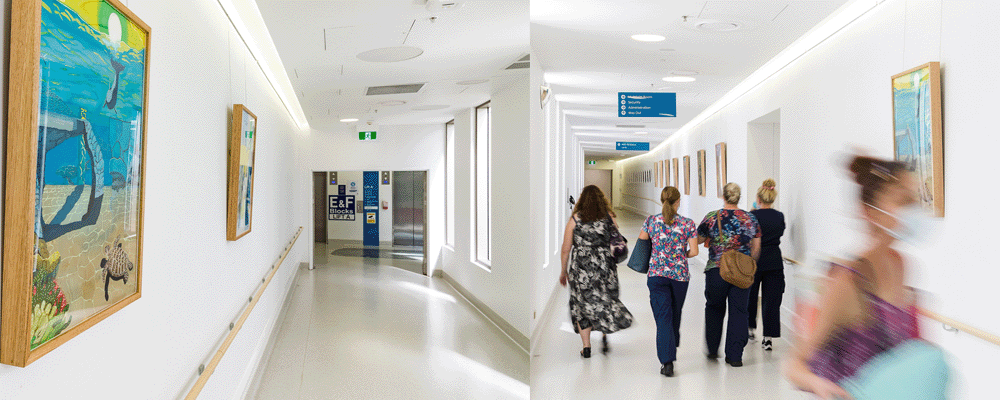
The lush Bundjalung Country surrounding Lismore Base Hospital has provided sanctuary to people and wildlife for millennia. A sanctuary is welcoming, calming, safe and sustaining. A hospital may also be thought of as a sanctuary: a place we go to feel cared for, to heal.
The artworks you see displayed throughout the Lismore Base Hospital are part of the Art Trail, commissioned for the Hospital Redevelopment. The trail, curated by Art Pharmacy, brings together 36 artworks by nine local artists displayed across three hospital floors, each reflecting on the idea of sanctuary.
Artists that live on or share a strong connection to the Bundjalung Nation were selected for the project through an open expression of interest, with a selection panel that included representatives from community, Northern NSW Local Health District staff, Arts Northern Rivers and informed by local Aboriginal Elders.
From the serene green of the Big Scrub to the shimmering blue surface of a coastal lake, experience the Art Trail and your sense of sanctuary by scrolling through this page or walking the floors.
Photo credits: Lisa Gough.
Level 4 – Linkway Artworks
- Tom Wolff
– ‘Untitled’
-
‘Untitled’, 2022 – 35mm photograph, 771 x 842mm
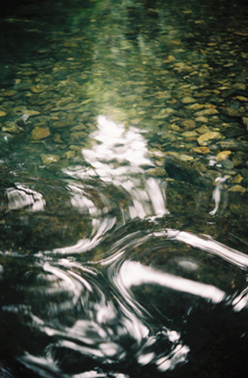
Bio
Tom Wolff (b. 1991) is a photographer and writer who spends a lot of time outdoors. Through his photos, Wolff captures stories of people, places and the relationships that exist in the natural world.
Artist statement
Our waterways are a sanctuary for so many creatures; from the small rainforest birds that come to bathe and drink on a crisp winter’s morning, to the freshwater crayfish that hunt for food in small rainforest streams and the platypus that emerge from their burrows to swim amongst the forest understoreys.
We know too well the power our waterways can muster to wreak destruction across the landscape, yet we mustn’t forget the sanctuary they can offer if we care for them properly. These important life forces have given us so much and it’s time we repaid the favour.
Conversation starters
- Imagine yourself trailing your fingers through the water.
- Does the water feel warm or cold to the touch?
- How does your body respond to the water?
- Tiffany Kingston
– ‘The Endless Loving Heart’
-
‘The Endless Loving Heart’, 2022 – acrylic on canvas, 841 x 594mm
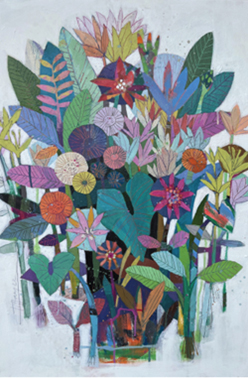
Bio
Frances Belle Parker (b. 1982) is an Indigenous Australian painter from Yaegl Country. In her practice, Parker explores her relationship with her mother’s land (Yaegl land), and Ulgundahi Island where her mother grew up.
Artist statement
‘Together We Journey’ tells of people from all walks of life together on a journey. As night falls and a vivid sunset beams from the skies, we acknowledge the exploration we undertake together through life. No matter what happened during the day, the presence of the sunset brings new beginnings, acknowledging that we’re all on our own journey and finding our feet together. The layers of the painting represent the many layers within each of us, our complexities and intricacies.
Conversation starter
- Imagine yourself standing under the rays of the sunset in this artwork.
- Can you think of a time in your life when you had a new beginning?
- What was your experience of a fresh start or starting something new?
- Frances Belle Parker
‘Together We Journey'
-
‘Together We Journey’, 2022 – acrylic on canvas, 841 x 594mm
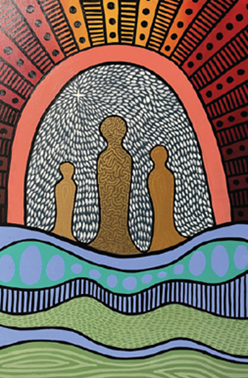
Bio
Frances Belle Parker (b. 1982) is an Indigenous Australian painter from Yaegl Country. In her practice, Parker explores her relationship with her mother’s land (Yaegl land), and Ulgundahi Island where her mother grew up.
Artist statement
‘Together We Journey’ tells of people from all walks of life together on a journey. As night falls and a vivid sunset beams from the skies, we acknowledge the exploration we undertake together through life. No matter what happened during the day, the presence of the sunset brings new beginnings, acknowledging that we’re all on our own journey and finding our feet together. The layers of the painting represent the many layers within each of us, our complexities and intricacies.
Conversation starter
- Imagine yourself standing under the rays of the sunset in this artwork.
- Can you think of a time in your life when you had a new beginning?
- What was your experience of a fresh start or starting something new?
-
Emily Imeson
– ‘Growing in Adversity’
-
‘Growing in Adversity’– 2022, acrylic on canvas, 841 x 594mm
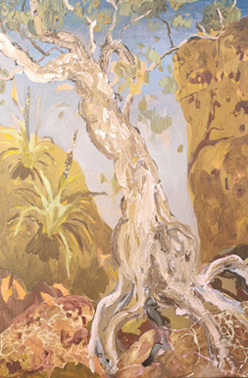
Bio
Emily Imeson (b. 1992) examines how landscape painting can be an important tool in responding to the twenty-first-century effects of climate change and impending ecological issues. A natural inquisitor, Emily’s practice fulfills an innate desire to understand human and non-human relationships, where landscape becomes the site for interconnectedness.
Artist statement
Remembering my time moving through the giant granite boulders on the edge of Tenterfield, this piece is intended to be optimistic, encouraging a shift in perspective to see the situation anew. It is not a tree caught between a rock and a hard place (another rock), but rather a symbiotic environment where life has found a way to grow, regardless. The rocks are not a restrictive force, but a source of nutrients, shelter, and support - much like a sanctuary. This piece is a metaphor of the health system, highlighting that with the right support (NSW health/symbiosis), nutrients from these rocks can be unlocked (nurses/doctors/fungi).
Conversation starter
- Can you spot the tree developing strongly regardless of being wedged among rocks?
- Can you make out where the tree might get its nutrients and supports?
- We all have personal challenges; how would you look at yours in a new light?
- Karyn Fendley
– ‘She Oak’
-
‘She Oak’ – 2022, acrylic on canvas, 841 x 594mm
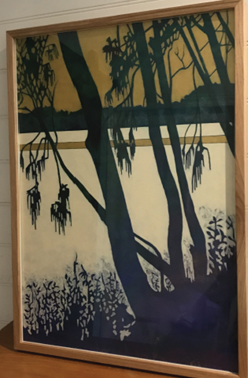
Bio
Karyn Fendley (b. 1970,) is a landscape artist from Mullumbimby. Her work explores how we remember the places we have visited, capturing the essence of those places through simple imagery. Her most recent paintings are informed by the coastal lakes and forests of the Arakwal, Bundjalung and Yuraygir National Parks in Northern New South Wales. These works play with placement of light and dark to depict the Australian summer, while locally identifiable motifs, colours and subjects express a specific sense of place.
Artist statement
A sweeping casuarina or ‘she oak’ is standing on the shore of a shining sunlit lake.
The cool shade offered by the she oak is a welcome shelter from the sun on a hot day. Looking out over the water from the cool shade of the trees, we feel a sense of relief. We have escaped the heat to relax and revive ourselves.
While the mature tree in this painting offers shelter for recovery, the young plants in the shade of the tree represent new beginnings and a hopeful future.
Conversation starter
- Observe the light reflecting off the water’s surface. What time of the day is it?
- Imagine looking down into the shimmering water, with gentle waves lapping at your ankles.
- What do you think you would see in the depths below?
- Sylvia Khan
– ‘Waterholes’
-
‘Waterholes’ – 2022, acrylic on canvas, 841 x 594mm
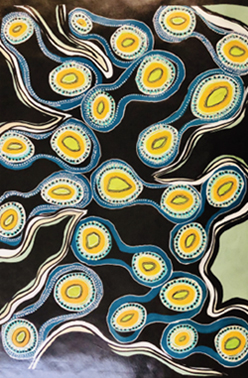
Bio
Sylvia Khan (b. 1980) was born at the Lismore Base Hospital on Bundjalung Country. She identifies as a Koori (Aboriginal) Artist from the Bandjalang Clan, Box Ridge Mission. In her practice, Khan interprets lessons and storylines in language from her maternal Koori grandmother. She is interested in the way these stories have been passed down through generations to form a rich, thriving and surviving culture.
Artist statement
This artwork depicts the waterholes as a place to refresh and rejuvenate, representing endurance, nourishment, strength and resilience. I wanted to create an artwork that energises and empowers viewers on their journey towards rehabilitation and recovery. When I think of community access to healthcare services and the process of recovery, I am inspired to create a work that represents hope and optimism during a difficult time.
Conversation starter
- What colours do you associate with joy in this picture?
- Everyone needs some cheering up every now and then; what brings you the most joy?
-
Dylan Bolt
– ‘Blue Haven’
-
‘Blue Haven’, 2022 – oil painting on linen canvas, 841 x 594mm
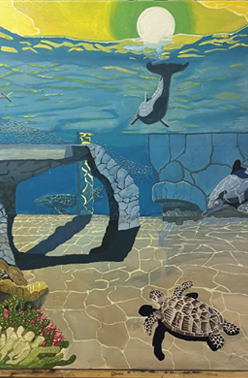
Bio
Dylan Bolt (b. 1983) is an Indigenous Australian painter from Bundjalung Country. In his practice, Bolt explores his relationship with the ocean, as well as the relationship between animals and their environments.
Artist statement
This work is about my connection to the ocean. Whenever I am in the ocean, I experience a sense of awe towards this place where I can spend hours and lose track of time. When I am closest to the ocean is when I feel I am in my sanctuary, my haven. I have had the privilege of snorkelling in the Great Barrier Reef and am taken back to this memory when I look at this painting.
Conversation starter
- For many people, animals bring comfort and companionship.
- Is there an animal that you share a special connection with?
-
Leah Bartholomew
– ‘Byron Headlands’
-
‘Byron Headlands’, 2022 – acrylic on canvas, 841 x 594mm
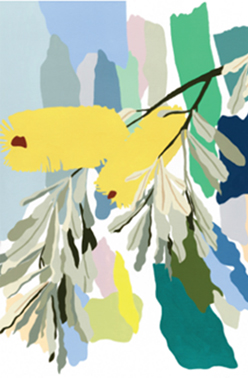
Bio
Leah Bartholomew (b. 1978) uses her art to explore abstract representation of the beauty found in the plants and wildlife of her local environment. Her optimistic, colourful artworks are a response to her daily interactions with her local base, Byron Bay, NSW.
Artist statement
The Northern NSW region is one of the most biodiverse places in Australia. I have painted an array of natural flora of all shapes, sizes and hues to represent the beauty and diversity of the people in the region, who just like the natural landscape, bring life to the environment. Through this piece, I hope that the viewer can reflect on their own connection to their local area and the diversity of life, in both people and plants, that makes it unique.
Using bright, cheerful colours, I wanted to create a feeling of playfulness, of setting aside your worries and choosing to find brightness when life feels dim. I was inspired by my childhood memories of playing in nature, when the world felt big and opportunities felt endless.
Conversation starter
- Take some time to look at the flora, then gently close your eyes.
- Try to picture it again in your mind.
- What specific details of the painting stand out to you?
-
Matthew Sansom
– ‘Arakwal Lassiandra’
-
‘Arakwal Lassiandra’, 2022 – oil on canvas, 841 x 594mm
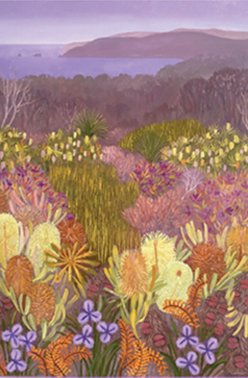
Bio
Matthew Sansom (b. 1974) explores creative narratives of nature, light and design through his artwork. Taking observations of the natural world as his starting point, Sansom constructs a unique vision through composition, pigment, and brush stroke.
Artist statement
This painting is a medley of native plants commonly seen along the coastline of the Northern Rivers and the Arakwal National Park that stretches along the beach behind Byron Bay. A micro perspective of purple fringe lilies, native lassiandra, banksia, grass trees, wattle and bracken can be seen in the foreground. The horizon fades into a macro vision of dried shrubs, banksia coastal trees and paperbarks interacting with a soft lavender afternoon sky. A sandy footpath invites you on a sojourn that leads to the beach.
Conversation starter
- Imagine yourself walking through the dense plant life in this painting.
- How does the scrub feel as it brushes against your skin? Is it rough and dry, or soft as flower petals?
- Imagine being able to smell the flowers in this landscape.
- What sort of scents could the blossoms have?
Level 4 – Greenery in Nature
-
Frances Belle Parker
– ‘Caring For Country’
-
‘Caring For Country’, 2022 – acrylic on canvas, 841 x 594mm
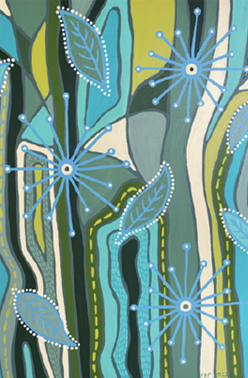
Bio
Frances Belle Parker (b. 1982) is an Indigenous Australian painter from Yaegl Country. In her practice, Parker explores her relationship with her mother’s land (Yaegl land), and Ulgundahi Island where her mother grew up.
Artist statement
‘Caring for Country’ represents the diverse shades of green in nature. Green is a healing colour that offers peace and calm to many. From the leaves on trees to blades of grass, green is a reminder to protect, nurture and care for this land. The markings in the background depict the paths we take as humans, through this landscape.
Conversation starter
- The green shades in our environment can be remarkably diverse – from vibrant lime to the deepest emerald.
- Think of the last time you visited a special place in nature. How many shades of green could you see?
- What makes the place where you were born special? Consider something about your birthplace that you are grateful for.
-
Emily Imeson
– ‘Ultimate Sanctuary’
-
‘Ultimate Sanctuary’, 2022 – acrylic on canvas, 841 x 594mm
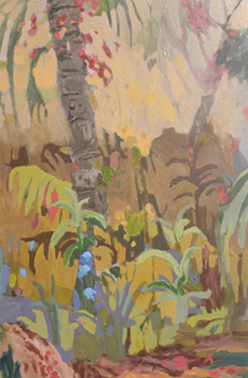
Bio
Emily Imeson (b. 1992) examines how landscape painting can be an important tool in responding to the twenty-first-century effects of climate change, and impending ecological issues. A natural inquisitor, Emily’s practice fulfills an innate desire to understand human and non-human relationships, where landscape becomes the site for interconnectedness.
Artist statement
This piece journeys through one of the original sanctuaries of this land; The Big Scrub. Our local environment is overwhelmingly green which, for me, can become oversaturated. It is in moments of contrast between colours that I am reminded of how beautiful and lush the greenery within our landscape is. The contrasting colours I used are red, blue, and pale yellow, which are the fruits of the walking stick palm, native ginger, and the young fruit hanging from Bangalow palms. The location is a memory of walking along Iron Pot Creek at Toonumbah Dam where the air was fresh and beauty filtered through the dappled light, leaving me feeling elated, safe and protected.
Conversation starter
- Imagine yourself picking fruits in this painting. How do they feel in your hands? How do they taste?
- Is there a place in nature where you feel most safe?
- What makes this place a safe haven to you?
- Imagine yourself lying down on the ground in this safe place.
- What sounds can you hear around you?
- What smells can you sense in the air?
-
Tom Wolff
– ‘Untitled’
-
‘Untitled’, 2022 – 35mm photograph, 771 x 842mm
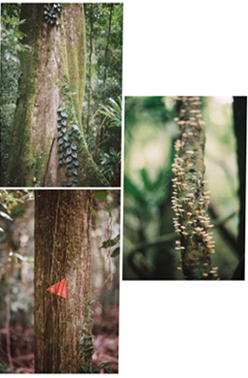
Bio
Tom Wolff (b. 1991) is a photographer and writer who spends a lot of time outdoors. Through his photos, Wolff captures stories of people, places and the relationships that exist in the natural world.
Artist statement
The Big Scrub originally covered around 900 square kilometres of the Bundjalung nation. Wide-scale deforestation by early Europeans reduced these majestic forests to isolated remnants scattered across the region, reducing their complex ecosystems to a shadow of their former selves. In the last half century, community efforts have doubled the size of the remaining Big Scrub through plantings and restoration programs.
While we still may have a long way to go in recreating this vast rainforest, plenty of magic remains in those pockets, which continue to provide sanctuary to an incredible array of local native flora and fauna that have survived against all odds.
Conversation starter
- Close your eyes and imagine standing amongst the big scrub.
- What does it feel like to touch the moss in the photograph?
- Where do you imagine you will go if you follow the arrow?
-
Karyn Fendley
– ‘Beautiful Morning’
-
‘Beautiful Morning’, 2022 – acrylic on canvas, 841 x 594mm
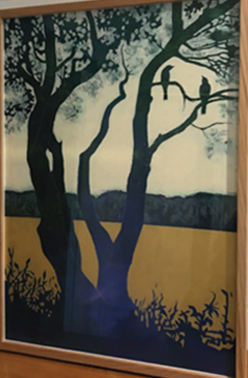
Bio
Karyn Fendley (b. 1970) is a landscape artist from Mullumbimby, whose work explores how we remember the places we have visited, and how to capture the essence of those places with simple imagery. Her most recent paintings are informed by the coastal lakes and forests of the Arakwal, Bundjalung and Yuraygir National Parks in Northern New South Wales. These works play with placement of light and dark to depict the Australian summer, while locally identifiable motifs, colours and subjects express a specific sense of place.
Artist statement
The forests that grow along banks of the coastal lakes of Northern New South Wales are places of great beauty and tranquility, providing a habitat and safe breeding ground for many native birds and animals.
In this painting, a pair of nesting birds greets the morning light from the canopy of their lakeside tree, representing new beginnings and new life. I hope this artwork encourages the viewer to reflect on our connection to nature and the peace and comfort it can offer us.
Conversation starter
- Observe the two birds perched side by side on the tree.
- Do you imagine them singing to each other?
- What would the chirping birdsong sound like?
- Imagine yourself in this landscape, climbing a tree with a friend. What would you talk about as you sit side by side on the branch?
- What sights can you see as you look out over the lake?
-
Sylvia Khan
– ‘Jalum Dreaming’
-
‘Jalum Dreaming’, 2022 – acrylic on canvas, 841 x 594mm
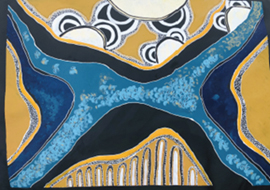
Bio
Sylvia Khan (b. 1980) was born at the Lismore Base Hospital on Bundjalung Country. She identifies as a Koori (Aboriginal) Artist from the Bandjalang Clan, Box Ridge Mission. In her practice, Khan interprets lessons and storylines in language from her maternal Koori grandmother. She is interested in the way these stories have been passed down through generations to form a rich, thriving and surviving culture.
Artist statement
This painting depicts a story of Jalum Dreaming. ‘Jalum’ means ‘fish’, a sustainable and abundant source of nutrition. The painting represents the connectedness we feel when we come together to access healthcare services. Through calming neutral tones, I wanted to create a story that reflects the importance of connection and sustaining positive relationships that lead to health and wellbeing of others.
Conversation starter
- Take a moment to pause and consider your relationships with your loved ones.
- Focus on your breathing, count two deep breaths in and count three deep breaths out.
- Place a hand on your belly to feel the air moving through your body. What images come to your mind?
- Sylvia Khan
– ‘Gurraman Jagun (Kangaroo Country)’
-
‘Gurraman Jagun (Kangaroo Country)’, 2022 – acrylic on canvas, 841 x 594mm
Bio
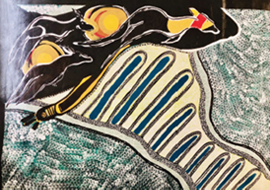
Sylvia Khan (b. 1980) was born at the Lismore Base Hospital on Bundjalung Country. She identifies as a Koori (Aboriginal) Artist from the Bandjalang Clan, Box Ridge Mission. In her practice, Khan interprets lessons and storylines in language from her maternal Koori grandmother. She is interested in the way these stories have been passed down through generations to form a rich, thriving and surviving culture.
Artist statement
This painting illustrates the connection to Jullabee, meaning ‘Spirit Totem’, depicted as the Gurraman (Kangaroo). I wanted to reflect the cultural connection that women feel in their journey of health and recovery as well as the history of struggle for healthcare access experienced by many Doobais (Bundjalung women). By campaigning for better healthcare access, we can strengthen the connection between the healthcare system and those who use it, and in turn create meaningful connections to each other.
Conversation starter
- Observe the ‘Gurraman’’ in the top right of the image. Do you imagine them slowing down or gaining pace?
- Where do you imagine the ‘Gurraman’ are journeying?
- Consider your health and healing journey for a moment. What has assisted you in healing your health?
-
Tiffany Kingston
– ‘Connected Lands’,
‘The Unspoken World’
-
‘Connected Lands’, 2022 – acrylic on canvas, 841 x 594mm
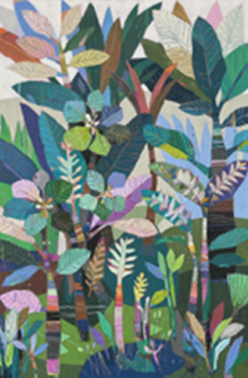
‘The Unspoken World’, 2022 – acrylic on canvas, 841 x 594mm
Bio
Tiffany Kingston (b. 1969) is a contemporary painter whose practice explores how immersion in nature and gardening can help us to develop a sense of self and awaken a greater understanding of the preciousness of all living things.
Artist statement
Exploring the notion of sanctuary, I was taken by the natural habitat around Byron Bay, in particular the abundance of foliage in the local sub-tropical forests and wetlands. This is my sanctuary, a place that I feel most connected to spiritually. This work focuses on the connection and energy shared between habitats and how we may observe this connection by spending meaningful time in nature.
Conversation starter
- What colours stand out to you in this artwork?
- How many times can you count this colour in this work?
- Can you pick a favourite flower from the painting? How do you imagine the flower smells?
-
Tom Wolff
– ‘Untitled’
-
‘Untitled’, 2022 – 35mm photograph, 771 x 842mm
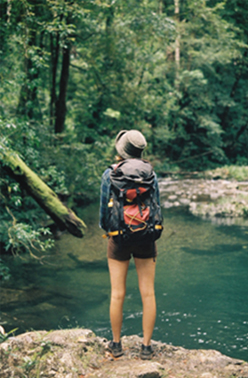
Bio
Tom Wolff (b. 1991) is a photographer and writer who spends a lot of time outdoors. Through his photos, Wolff captures stories of people, places and the relationships that exist in the natural world.
Artist statement
Someone told me once that in times of great stress, uncertainty and joy – a daily occurrence in a hospital – people interact deeply with the art on the walls. I hope that this photo can bring some form of sanctuary to you, the person reading this right now. The natural world has always provided me with a sanctuary; if just a small part of the Gondwanan rainforest creeps its way into these fluorescent-lit halls, then I’d be happy.
Conversation starter
- Imagine yourself standing on the edge of the pool observing the emerald waters. Can you see the bottom?
- Do you have a favourite place in nature?
- How do you feel when you are in that place?
-
Frances Belle Parker
– ‘Knowing Strength’
-
‘Knowing Strength’, 2022 – acrylic on canvas, 1000 x 1200mm
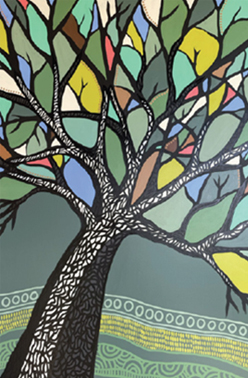
Bio
Frances Belle Parker (b. 1982) is an Indigenous Australian painter from Yaegl Country. In her practice, Parker explores her relationship with her mother’s land (Yaegl land), and Ulgundahi Island where her mother grew up.
Artist statement
‘Knowing Strength’ offers a new perspective. Looking up through a dense canopy of trees, the viewer is encouraged to look beyond the surface and to appreciate their surroundings, to find beauty wherever they are. By looking towards the sky, we are given a glimpse of light, of new horizons and the hope that time brings. The canopy of leaves in different stages of life represents the individuality in people that we can recognise when we stop to take a look around.
Conversation starter
- Imagine yourself reaching up and growing towards the sky like a tall tree.
- Can you think of a future wish or hope that you have?
- Take a moment to imagine this taking place. What would it look like?
-
Matthew Sansom
‘The Grass is Always Greener’
-
‘The Grass is Always Greener’, 2022 – oil on canvas, 841 x 594mm
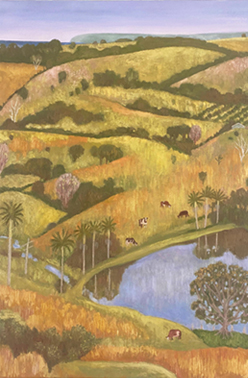
Bio
Matthew Sansom (b. 1974) explores creative narratives of nature, light and design through his artwork. Taking observations of the natural world as his starting point, Sansom constructs a unique vision through composition, pigment, and brush stroke.
Artist statement
‘The Grass is Always Greener’ is based on plein-air studies, capturing the relationship between nature and the farm worker on the land. Pastures of grass interconnect with thickets of trees, fence lines, and ancient fig. After the 2022 floods, the hills are teeming with an abundance of green tones mixed with orange sienna remnants of summer decay, features that reflect the ingenuity of both nature and the farming community.
Conversation starter
- What do you see in the landscape of this painting?
- How many colours can you notice in the grassy fields?
- When you see these colours, what do they remind you of?
Level 6 – Water
-
Dylan Bolt
– ‘Marine Reserve’
-
‘Marine Reserve’, 2022 – oil painting on linen canvas, 841 x 594mm
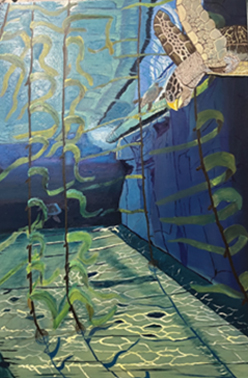
Bio
Dylan Bolt (b. 1983) is an Indigenous Australian painter from Bundjalung Country. In his practice, Bolt explores his relationship with the ocean, as well as the relationship between animals and their environments.
Artist statement
The ocean is a sanctuary for wildlife. Marine reserves offer protected areas removed from human activity. This painting reflects on these safe places for marine life and the need to preserve them. Green sea turtles are one of my favourite marine animals because they are calm and gentle creatures, qualities I see in myself. The kelp forest you see in this painting is just one of the many places within the ocean where marine life finds a safe haven,
Conversation starter
- Imagine yourself swimming alongside the turtle in this painting.
- Do you ever find that the natural world inspires awe in you?
- Can you recall a location where you had this experience?
-
Dylan Bolt
– ‘A Mother’s Love’
-
‘A Mother’s Love’, 2022 – oil painting on linen canvas, 841 x 594mm
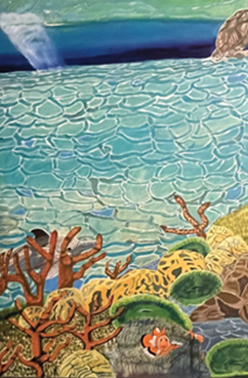
Bio
Dylan Bolt (b. 1983) is an Indigenous Australian painter from Bundjalung Country. In his practice, Bolt explores his relationship with the ocean, as well as the relationship between animals and their environments.
Artist statement
A mother’s love is universal, seen in ocean mammals like bottlenose dolphins who nurture and give their young calves love, protection and a sanctuary to play and learn while they are growing up. I wanted to convey this universal affection from my own sanctuary, painting the ocean, while relating this to my own family. I hope viewers can connect with the mother bottlenose dolphin loving, protecting and guiding the calf and be reminded of the nurturing figures in their own lives.
Conversation starter
- Think of someone in your life who has nurtured you. How did they care for you?
- If you could bring this person on a journey to a place special to you, where would you go?
- What stories would you share with each other?
-
Dylan Bolt
– ‘Local Oasis’
-
‘Local Oasis’, 2022 – oil painting on linen canvas, 1000 x 1200mm
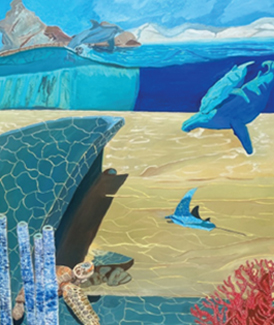
Bio
Dylan Bolt (b. 1983) is an Indigenous Australian painter from Bundjalung Country. In his practice, Bolt explores his relationship with the ocean, as well as the relationship between animals and their environments.
Artist statement
In this painting, I wanted to highlight our safe places, like a bed on a cold stormy night, or a fireplace. I wanted to bring Julian Rocks to people’s attention; a local oasis for many marine animals and a place where I had the pleasure of snorkelling when times have been hard. I remember seeing fish hide and find their sanctuary among the rocks. Through this painting, I hope that viewers may see how precious these places are, that they are reminded of their own safe places and find comfort in these memories.
Conversation starter
- Do you have a special place in nature that’s like a sanctuary to you?
- What is your favourite memory of this place?
- If you could take something from your sanctuary to bring with you everywhere you go, what would it be?
-
Karyn Fendley
– ‘Tranquil Lake’,
‘Serene Lake’
-
‘Tranquil Lake’, 2022 – acrylic on canvas, 841 x 594mm
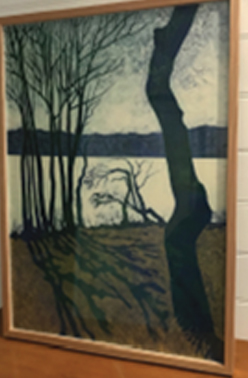
‘Serene Lake’, 2022 – acrylic on canvas, 841 x 594mm
Bio
Karyn Fendley (b. 1970) is a landscape artist from Mullumbimby, whose work explores how we remember the places we have visited, and how to capture the essence of those places with simple imagery. Her most recent paintings are informed by the coastal lakes and forests of the Arakwal, Bundjalung and Yuraygir National Parks in Northern New South Wales. These works play with placement of light and dark to depict the Australian summer, while locally identifiable motifs, colours and subjects express a specific sense of place.
Artist statement
Whenever I spend time in nature, I feel restored and healed. I often visit the places depicted in my artwork, in particular the forests that grow along the coastal lakes of our region. ‘Serene Lake’ ’and ‘Tranquil Lake’ are a pair of paintings inspired by a visit to Lake Hiawatha near Minnie Waters in Northern NSW. These natural landscapes capture the changing seasons and cycles of life shared by us all.
Conversation starter
- Imagine sitting by the lakeside, gazing out towards the opposite shore.
- Is it a hot and clammy day, or is it cool and crisp? What do you imagine is on the other side of the water?
- Can you imagine yourself getting comfortable in the landscape?
Level 7 – Flowers, Lavender
-
Emily Imeson
– ‘Things I Love’
-
‘Things I Love’, 2022 – acrylic on canvas, 841 x 594mm
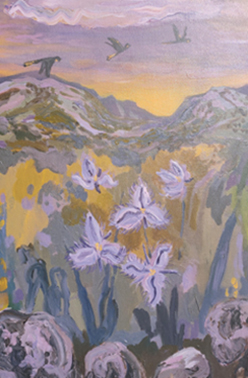
Bio
Emily Imeson (b. 1992) examines how landscape painting can be an important tool in responding to the twenty-first-century effects of climate change, and impending ecological issues. A natural inquisitor, Emily’s practice fulfills an innate desire to understand human and non-human relationships, where landscape becomes the site for interconnectedness.
Artist statement
‘Things I love’’ is inspired by the practice of counting things you are grateful for at the end of each day. It is a practice that, over time, increases my overall gratitude, especially for the simple things. I have included 3 fringe lilies, 5 yellow tailed black cockatoos, and 8 rocks; this is to provide potential activities for patients and their visitors, a talking point for all ages. The colours are very important as the piece celebrates the splendour of sunset, the yellow (complementary to purple) is my colour of hope, optimism, joy, warmth and sanctuary (it is the colour of my partner).
Conversation starter
- Can you count three things you are grateful for?
- If you could represent each of these things with a colour, what colours would they be?
- Matthew Sansom – ‘Colours of the Bay’
-
‘Colours of the Bay’, 2022 – oil on canvas, 841 x 594mm
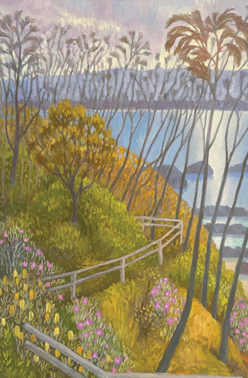
Bio
Matthew Sansom (b. 1974) explores creative narratives of nature, light and design through his artwork. Taking observations of the natural world as his starting point, Sansom constructs a unique vision through composition, pigment and brush stroke.
Artist statement
At certain times, the bay shines ultramarine blue. My eyes team this colour with the shadow in the Pandanus trees and the light reflecting off the native succulents, along with the silvery blue of the spinifex grass. It’s easy to see why Byron Bay is considered the jewel of the Northern Rivers, a place for creation and self-reflection. Framed by the Wollumbin mountain ranges and white sandy beaches, the sun-baked rocky nooks are a place to rejuvenate and take in the elements.
Conversation starter
- Can you imagine yourself walking along the track in the painting?
- Does the ocean air feel warm or cool?
- What can you make out in the distance? What do you see just over the fence?
-
Frances Belle Parker
– ‘Remembering Peace’
-
‘Remembering Peace’, 2022 – acrylic on canvas, 841 x 594mm
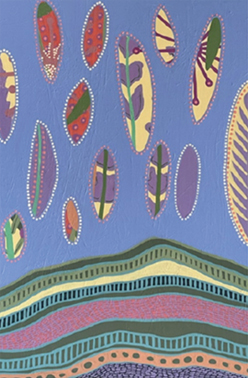
Bio
Frances Belle Parker (b. 1982) is an Indigenous Australian painter from Yaegl Country. In her practice, Parker explores her relationship with her mother’s land (Yaegl land), and Ulgundahi Island where her mother grew up.
Artist statement
The colour of lavender in its various shades is soft and calming. For me, lavender represents a sense of peace and pride. Lavender, standing bold and proud in a field, looks confident and happy to be noticed. Through this painting, I wanted to symbolise the personal journey of finding confidence, to stand out in a field of one’s own. I hope that the viewer will reflect on their own journey towards self-confidence and any setbacks they have overcome along the way.
Conversation starter
- In this artwork, the lavender colour represents confidence. What colour do you wear when you want to feel confident?
-
Sylvia Khan
– ‘Flower on Country
-
‘Flower on Country’, 2022 – acrylic on canvas, 841 x 594mm
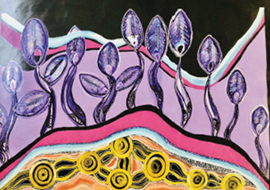
Bio
Sylvia Khan (b. 1980) was born at the Lismore Base Hospital on Bundjalung Country. She identifies as a Koori (Aboriginal) Artist from the Bandjalang Clan, Box Ridge mission. In her practice, Khan interprets lessons and storylines in language from her maternal Koori grandmother. She is interested in the way these stories have been passed down through generations to form a rich, thriving and surviving culture.
Artist statement
This artwork depicts a storyline of caring for Country, land, sea and waters, which create a sense of belonging to the earth. This imagery reflects the strong sense of connection we feel to spirituality and journey through land by following pathways of support and continuity of care. The yellow circles in my work demonstrate the connection between community and Country. The dotted sections depict the tracks we make when we journey across Country, leaving our footprints behind on our beautiful Bundjalung Nation.
Conversation starter
- Take a moment to trace over the patterns and pathways in the artwork.
- Observe how the lines connect each shape.
- What brings you a sense of connection and belonging to the people and places in your life?
-
Emily Imeson
– ‘Support Networks’
-
‘Support Networks’, 2022 – acrylic on canvas, 1200 x 1000mm
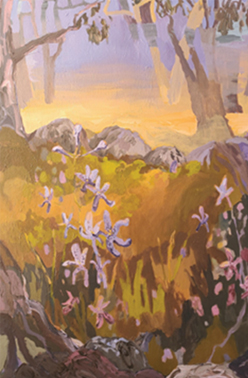
Bio
Emily Imeson (b. 1992) examines how landscape painting can be an important tool in responding to the twenty-first-century effects of climate change, and impending ecological issues. A natural inquisitor, Emily’s practice fulfills an innate desire to understand human and non- human relationships, where landscape becomes the site for interconnectedness.
Artist statement
This piece is inspired by a walk I took on my parents’ property, a place I associate with support and sanctuary. While walking, something pink caught my eye, which I later learnt was a Hyacinth orchid. These orchids have lost their green foliage, which means that they are unable to photosynthesise like most plants. Instead, they rely on a nearby tallowwood tree and an underground fungi network for nutrients. This painting represents dawn; a new day. The yellow is a complimentary colour to purple and my personal colour of all things sanctuary. The trees in the background represent interconnectedness and support networks, which can be seen in the hospital every day.
Conversation starter
- Can you imagine yourself leaning against a tallowwood tree, feeling the warm breeze?
- Observe the tall, study trees in the background of this painting. For the artist, these trees represent support and strength.
- What is your personal strength? How do you use this strength to make others feel better?
- Consider a person or object that helps you feel strong and supported in your life.
-
Tiffany Kingston
– ‘As One We Dream'
-
‘As One We Dream’, 2022 – acrylic on canvas, 841 x 594mm
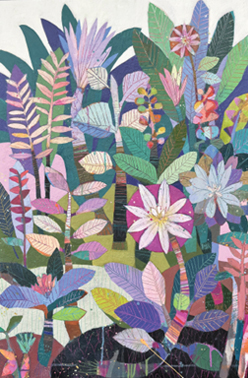
Bio
Tiffany Kingston (b. 1969) is a contemporary painter, whose practice explores how immersion in nature and gardening can help us to develop a sense of self and awakening a greater understanding of the preciousness of all living things.
Artist statement
I am inspired by wild-flowers and the shapes of leaves. Each shape and form cannot exist without the other, growing together as untamable beauty. This connection between each flower and leaf in the landscape inspires us to restore and rejuvenate through our love of nature and embrace the beauty in ourselves.
Conversation starter
- Imagine yourself among the flowers in the painting. Are you standing, sitting or lying down?
- Which of your five senses are you most aware of in this picture?
- Can you make a gentle movement or gesture to express this feeling?
- Leah Bartholomew
– ‘Absorbing Light’
-
"Absorbing Light’, 2022 – acrylic on canvas, 860 x 680mm
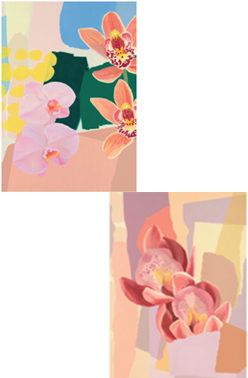
‘The Orchid Journals’, 2022 – acrylic on canvas, 860 x 680mm
Bio
Leah Bartholomew (b. 1978) uses her art to explore an abstract representation of the beauty found in the plants and wildlife of her local environment. Her optimistic, colourful artworks are a response to her daily interactions with her local base, Byron Bay, NSW.
Artist statement
Growing up in Tweed Heads has had a huge influence on my art. The local flora of the coast are daily inspirations for my art practice and bring feelings of peace whenever I immerse myself in that environment. I have used a warm pink palette to display femininity and nurture, with blossoming flowers as the focal point of the work to embody growth and vitality.
Through these works, I hope that the viewer reflects on their struggles and uses softer intonation in their inner voice, speaking kindly to themselves and offering compassion as they navigate life’s hurdles. These artworks offer a moment of serenity to the viewer, encouraging them to share their burdens and find ways to make life a little lighter.
Conversation starter
- Take some time to rest your eyes on the painted blossoms while paying attention to what you hear.
- What sounds are you currently hearing, are they near or far?
- What kind of sounds are they? Are they high or low pitched?
-
Leah Bartholomew
– ‘Window Orchids’
-
"Window Orchids’, 2022 – acrylic on canvas, 1200 x 1000mm
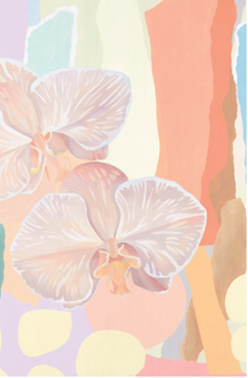
Bio
Leah Bartholomew (b. 1978) uses her art to explore an abstract representation of the beauty found in the plants and wildlife of her local environment. Her optimistic, colourful artworks are a response to her daily interactions with her local base, Byron Bay, NSW.
Artist statement
Growing up in Tweed Heads has had a huge influence on my art. The local flora of the coast are a daily inspiration for my art practice and bring me feelings of peace whenever I immerse myself in the environment. I have used a warm pink palette to represent femininity and nurture, with blossoming flowers as the focal point of the work to embody growth and vitality.
Through these works, I hope that the viewer can reflect on their struggles, speak kindly to themselves, and offer compassion as they navigate life’s hurdles. These artworks offer a moment of serenity to the viewer, encouraging them to share their burdens and find ways to make life a little lighter.
Conversation starter
- This painting expresses kindness.
- What does kindness mean to you and how do you express it to those around you?
- What small act of kindness have you done for someone today?